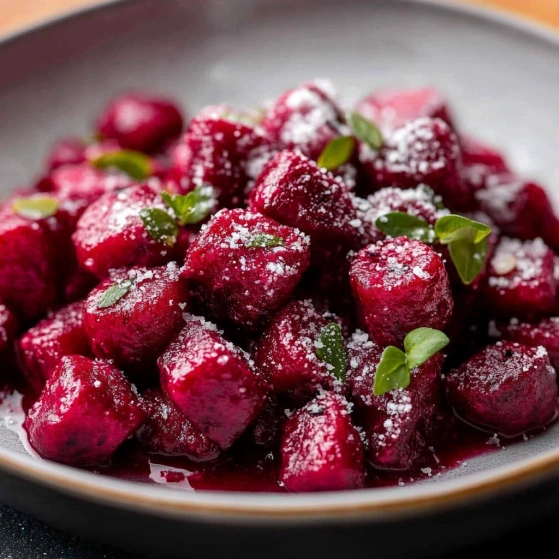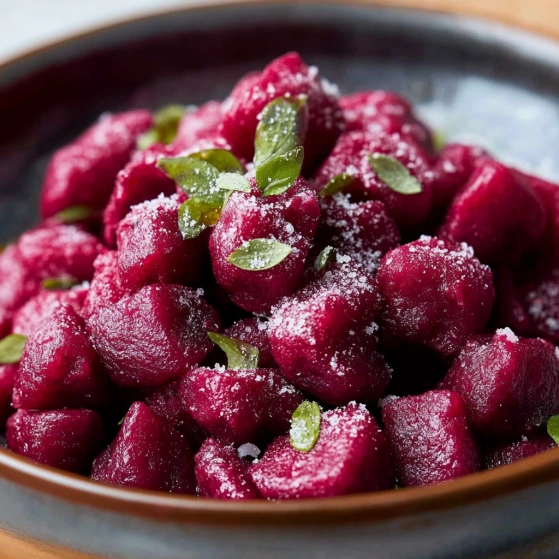 Pin it
Pin it
This beet gnocchi recipe transforms humble ingredients into a stunning pink pasta that never fails to impress dinner guests while being surprisingly simple to prepare. The earthy sweetness of roasted beets pairs perfectly with sage butter for a restaurant-quality dish made right in your kitchen.
I first created this beet gnocchi when trying to introduce more vegetables into my family's pasta nights. What started as a colorful experiment has become our favorite way to use beets from the farmers market, with even the most vegetable-averse family members requesting it regularly.
Ingredients
- Medium beet: Provides gorgeous color and subtle earthy sweetness. Look for firm beets with smooth skin and no soft spots.
- Large russet potato: Creates the perfect gnocchi texture. Choose starchy potatoes rather than waxy varieties.
- Whole wheat flour: Adds nutritional value and a pleasant nutty flavor.
- Fresh sage: Complements the earthiness of beets perfectly with its aromatic flavor.
- Salted butter: Creates the simple but luxurious sauce that coats each gnocchi.
- Parmesan cheese: Adds savory depth and helps bind the dough together.
Step-by-Step Instructions
- Roast the Vegetables:
- Preheat oven to 425°F. Place beet in a dish with water covering three-quarters of its height and cover tightly with foil. Poke potato all over with a fork and place on a parchment-lined baking sheet. Roast both for 45 minutes until completely tender when pierced with a fork. The slow roasting concentrates flavors and ensures proper texture.
- Prepare the Beet Mixture:
- After cooling slightly, peel the beet by gently rubbing the skin off with your fingers. Chop roughly and blend in a food processor with egg, Parmesan, and salt until completely smooth with no visible bits remaining. This creates the vibrant base for your gnocchi.
- Prepare the Potato:
- Peel the roasted potato while still warm and grate through small holes of a box grater or press through a ricer for the fluffiest texture. Avoid mashing or processing the potato which can make gnocchi dense and gummy.
- Form the Dough:
- Gently fold together the potato and beet mixture with minimal handling. Gradually add flour until the dough comes together but remains soft. Stop adding flour once the dough is no longer sticky but still tender. Overmixing or adding too much flour will create tough gnocchi.
- Shape the Gnocchi:
- Divide dough into workable portions and roll into half-inch thick ropes on a lightly floured surface. Cut into one-inch pieces and optionally roll each piece over fork tines to create ridges that will catch the sage butter sauce. The ridges also help the gnocchi cook more evenly.
- Cook the Gnocchi:
- Drop small batches into well-salted boiling water. When they float to the surface, allow them to cook 30 seconds longer before removing with a slotted spoon. Avoid overcrowding the pot which can cause uneven cooking and sticking.
- Finish with Sage Butter:
- Melt butter in a pan until bubbling, add fresh sage and pan-fry the boiled gnocchi until lightly toasted on each side. This crucial step adds texture contrast and infuses the gnocchi with buttery sage flavor.
 Pin it
Pin it
The first time I served this beet gnocchi to my Italian grandmother, she was skeptical about the modern twist on a classic. After one bite, she declared it was the most tender gnocchi she had tasted outside of her hometown and immediately asked for the recipe. Now we make it together whenever she visits, creating new family memories around this colorful dish.
Freezing Instructions
Freeze uncooked gnocchi on a parchment-lined baking sheet until solid, then transfer to a freezer bag. This prevents them from sticking together. When ready to cook, drop frozen gnocchi directly into boiling water without thawing and boil until they float plus one minute. The texture remains nearly identical to fresh, making this perfect for meal prep or unexpected dinner guests.
Perfect Pairings
While the sage butter sauce is delicious on its own, these gnocchi also pair beautifully with brown butter and toasted walnuts for added texture. For a heartier meal, try serving with roasted chicken and a simple green salad dressed with lemon vinaigrette. The acidity helps balance the richness of the gnocchi.
Troubleshooting Tips
If your dough feels too wet, add flour one tablespoon at a time until it reaches the right consistency. If too dry, moisten your hands with water while kneading rather than adding liquid directly. For the most tender gnocchi, handle the dough as little as possible once the flour is incorporated. Think of it like making pastry—gentle hands create the best texture.
 Pin it
Pin it
Frequently Asked Questions
- → Can I make beet gnocchi ahead of time?
Yes, you can prepare the gnocchi up to the shaping stage and freeze them on a baking sheet until solid. Transfer to a freezer bag and store for up to 3 months. Cook directly from frozen, adding a minute or two to the boiling time.
- → How can I tell when my gnocchi dough has enough flour?
The dough should be pliable and tender but not sticky when handled. Start with less flour than the recipe calls for and add more gradually until you reach the right consistency. The exact amount needed can vary based on moisture content in your beets and potatoes.
- → What can I substitute for sage in this dish?
Thyme, rosemary, or tarragon all work beautifully with beet gnocchi. For a different approach, try toasted walnuts and a drizzle of balsamic glaze instead of herbs.
- → Why did my gnocchi turn out dense and heavy?
Overworking the dough or adding too much flour can make gnocchi dense. Handle the dough gently, mixing just until ingredients are combined, and use only enough flour to prevent sticking. Also, ensure potatoes aren't overcooked, as waterlogged potatoes require more flour.
- → Do I need to create ridges on the gnocchi with a fork?
Creating ridges is optional but beneficial—they help sauce cling better to each piece. If you're short on time, you can skip this step and the gnocchi will still taste delicious.
- → Can I use different types of beets for this gnocchi?
Yes, red beets provide the vibrant pink color, but golden beets or Chioggia (candy stripe) beets work well too. Each variety will impart a slightly different flavor and color to the final dish.
